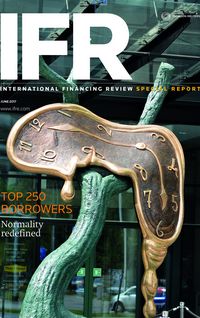Chinese borrowers are tapping offshore bond investors at a record clip this year, as rising onshore yields and a regulatory clampdown on riskier issuers cause domestic markets to cool.
Chinese state-owned enterprises and private companies had raised an equivalent of US$87bn by mid-May 2017 - roughly three times more than they had borrowed at the same point in the calendar a year earlier, according to Dealogic. At the same time, onshore borrowing slid to US$167bn - a fall of around 50%.
Bankers say part of the reason for that shift is because Beijing had tightened capital controls and restricted junk-rated property developers from issuing bonds onshore, prompting many to turn to the offshore market instead. Offshore high-yield issuance had surged to US$20bn by mid-May, up from a little under US$3bn a year ago.
An attempt by regulators to unwind excessive leverage in its domestic bond market has also curbed the pace of onshore debt deals.
“The onshore market was often working on leverage, so you had a lot of people who were effectively buying a lot of bonds with borrowed money. And with that margin buying being squeezed out, the market has slowed down tremendously,” said the head of debt capital markets for Asia-Pacific at a large global bank.
That regulatory intervention, coupled with a rise in short-term interest rates, has pushed up onshore borrowing costs, prompting many Chinese companies to rethink domestic bond issuance plans. The average yield for onshore corporate bonds issued in the first five months of 2017 was 5.40%, up from 4.90% over the same period a year ago, according to Thomson Reuters data. In the meantime, the average yield on US dollar-denominated Chinese corporate bonds fell to 3.70% at the end of May from 4.10% at the start of the year, according to a JP Morgan index.
“Last year, some of the central SOEs could receive three or five-year money at below 3% funding cost. That’s a historical low, so a lot of the demand was generated not because they had somewhere new to put the money but just because the funding was so cheap they wanted to refinance some of their debt,” said Jason Wang, head of DCM China at UBS in Hong Kong. “But with the surge in domestic funding costs, a lot of the issuers either cancelled their domestic bond issuance or they are holding and waiting to see what the funding costs will be.”
Funding expansion
Yet while the regulatory shackles imposed on real estate borrowers has displaced some issuance, the bulk of offshore bond sales have been driven by a need for Chinese companies to refinance existing debt and fund an overseas expansion push.
“If you look at the China offshore bond market as a whole, the market really started to take off in the second half of 2011. So, if you think about the bonds issued three to five years ago, there’s a huge wave of redemptions,” said Wang.
China’s central bank has also been steering domestic banks towards the offshore bond market to help finance the country’s overseas mergers and acquisitions strategy.
“The PBoC (People’s Bank of China) is encouraging Chinese banks to sell more dollar bonds in the offshore market so as to support activities for these SOEs without causing too much capital outflows,” said Helena Huang, chief China economist at ICBC Standard Bank in London. “From the authorities’ perspective, having Chinese banks raising dollars offshore and lending the proceeds to the SOEs for refinancing or M&A deals makes a lot more sense than giving SOEs direct borrowing from the international market.”
Some bankers say the record pace of issuance in the opening months of the year has been down to borrowers accelerating their debt sale plans amid concerns that market conditions might sour in the second half.
“Now everybody thinks there will most likely be three US rate hikes over the course of 2017, so a lot of issuers were just taking the opportunity to access the markets before any further rate hikes and the possibility of market volatility later in the year,” said the head of China DCM at a non-Chinese lender in Hong Kong.
For some market-watchers, the rise in offshore debt issuance comes as little surprise given China’s appetite for purchasing overseas assets.
“What we’re seeing in the market is exactly what the administration would like to see, which is foreigners funding the expansion of the Chinese private and state sectors at very low rates, and therefore sharing the burden of any potential future losses if there are any,” said Alan Siow, an emerging market corporate credit analyst at BlueBay Asset Management in London.
Yet international fund managers are increasingly being muscled out of certain offshore deals as Chinese investors with access to US dollars urgently seek dollar assets to deploy that cash, pushing up bond prices.
“These days, you typically see demand for SOE names being dominated by Chinese money and less price-sensitivity,” said the head of China DCM at a non-Chinese bank. “For strong investment-grade non-SOE names like Tencent and Baidu. you tend to see more international investors. But a lot of the SOEs’ order books are now quite heavily reliant on Chinese capital when they are aggressively driving price.”
That demand is often coming from the Hong Kong branches of Chinese banks, insurance firms or Chinese companies that have offshore treasury units, said Mark Follett, head of DCM origination for Asia ex-Japan at JP Morgan in Hong Kong.
ICBC Standard Bank’s Huang says the mix of investors has changed significantly in just a short time. Three years ago, around half of offshore China dollar bonds were held by US or non-Chinese asset managers. Now, that ownership has dropped to around 8%, she said.
The type of bonds up for grabs is also crimping demand among international investors.
“Whether it’s coal, steel, rail, cement or property, these are all capital-intensive sectors that need external funding, and those are the ones we don’t really want to fund - and that’s all we have on the menu,” said Siow. “A discerning investor would look at most of what comes out of China and say not for us, or not at this price.”
Running from bookrunning
In addition, bankers say some international investors are shunning new deals because they are disillusioned with the often chaotic bookrunning process many Chinese borrowers favour for offshore debt sales.
Whereas traditional bond syndications are collaborative, with banks working together to secure the best outcome for the issuer, Chinese borrowers typically pay bookrunners based on the number of orders they submit. That means banks are competing for investors and often shielding the provenance of those orders from other banks, a practice that frequently results in duplicate orders and vastly over-inflated order books.
“There are fewer and fewer international investors that are interested in these deals because the process is becoming broken,” said the head of DCM for Asia-Pacific at a global bank.
In one instance, Chinese borrower China Cinda Asset Management hired more than 20 bookrunners to manage its offshore bond sale. With banks submitting anonymous orders, what was thought to be a US$10bn book ended up being around half that size, undermining the execution of the deal.
“My wish is that one of these deals would really blow up to such an extent that some of those banks lose considerable sums of money or some of them get pursued by regulators. It might hopefully change things,” said a banker at another global lender.
Some market-watchers are expecting the pace of offshore issuance to slow in the second half of the year as the National Development and Reform Commission, the Chinese regulator responsible for approving offshore debt sales, sits on a backlog of potential deals.
“We know tons of clients who have put in a submission since the Chinese New Year and are still waiting approval,” said the head of China DCM at a non-Chinese lender. “We would have expected an even stronger pipeline than what we currently see if the Chinese NDRC process was much more expedited and more transparent.”
ICBC Standard Bank’s Huang says Beijing is seeking to limit property developers’ access to offshore markets following the surge of such bond sales in the first quarter of the year. Because of that, they are now turning to short-term debt markets, where they do not have to seek NDRC approval, she said.
The rise in onshore yields and a compression in offshore spreads might also spur demand for domestic deals again, potentially slowing offshore issuance, said Wilfred Wee, a fund manager at Investec Asset Management in Singapore.
“Previously, onshore credit was priced incorrectly and spreads were too tight. But that narrative has changed, so, at the margin, Chinese individuals might be a bit more interested in onshore paper,” he said.
Yet, even if offshore bond sales continue at this year’s record pace, bankers and investors are sanguine about what that means for China’s rapidly growing foreign currency debt pile.
“The amount of Chinese paper as a percentage of emerging market supply has become very large very quickly, but as a percentage of overall global supply it’s still very limited,” said JP Morgan’s Follett. “There’s a lot more potential for growth.”
To see the digital version of this special report, please click here
To purchase printed copies or a PDF of this report, please email gloria.balbastro@tr.com



